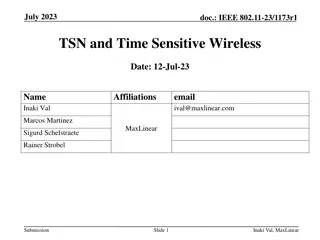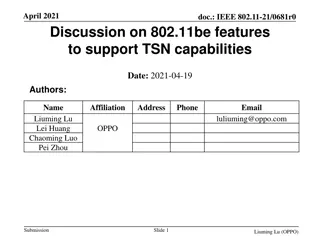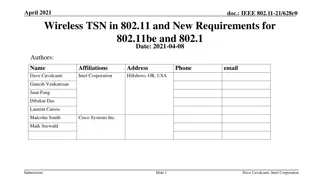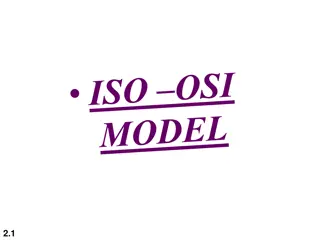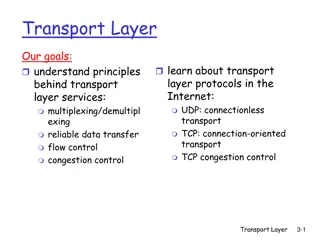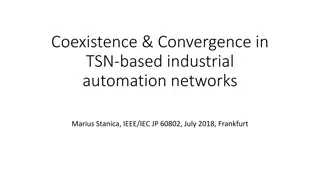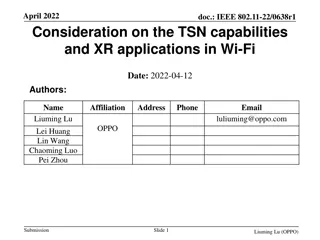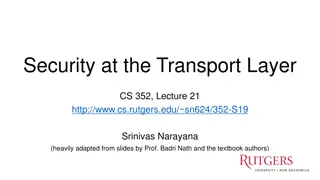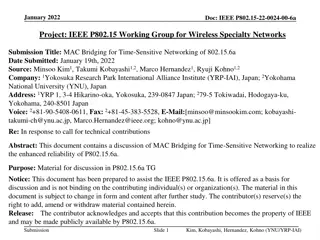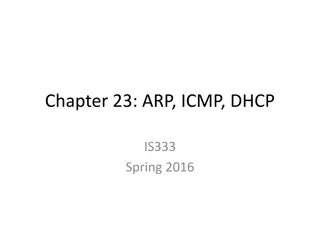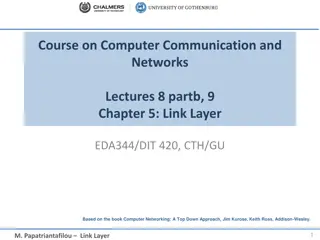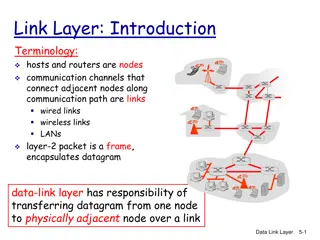LAYER 3 TSN -DRAFT 4
This presentation discusses the Layer 3 Time-Sensitive Networking (TSN) architecture from a network perspective, focusing on managing path selection and reservations between L3 devices across L2/L3 boundaries. It explores a model based on PCE-PE separation for handling independent but cooperating layers effectively.
Download Presentation

Please find below an Image/Link to download the presentation.
The content on the website is provided AS IS for your information and personal use only. It may not be sold, licensed, or shared on other websites without obtaining consent from the author.If you encounter any issues during the download, it is possible that the publisher has removed the file from their server.
You are allowed to download the files provided on this website for personal or commercial use, subject to the condition that they are used lawfully. All files are the property of their respective owners.
The content on the website is provided AS IS for your information and personal use only. It may not be sold, licensed, or shared on other websites without obtaining consent from the author.
E N D
Presentation Transcript
LAYER 3 FOR TSN LAYER 3 TSN DRAFT 4 Jouni Korhonen, Philippe Klein July 2014 1
SCOPING FOR THE DISCUSSION This presentation looks at the Layer 3 TSN from the SoHo or larger networks point of view. However, the solution space is not constrained to those. This is just a start for the discussion and proposing a set of protocols. There are no considerations for virtualized network infrastructure as of now. There are no considerations for redundancy as of now.. 2
REMEMBER THE HOMENET ARCHITECTURE ? Media nw Common nw NAS TV etc CPE Home nw Public server e.g. TV feed ISP DHCPv6-PD -> /64 /64 Home IoT HNET RTR HNET RTR Home Automation /64 /64 ? (unintentional loop) HNET RTR /64 Remote managed utilities 3rd party Managed nw /64 Visitor nw L3 routers are connected by multiple L2 segments not managed by L3. The challenge: How to manage path selection & reservation between L3 devices? How to manage path selection & reservation across L2/L3 boundaries? 3
ARCHITECTURE BASED ON PCE-PE MODEL Clear separation of independent but cooperating layers: Layer 3 topology and (non-)adjacent layer 2 topologies are handled separately. Role separation for layer 3 router: L3 PCE + L2 PCE or L3 PCC + L2 PCE . One router is an elected or preconfigured g0d-box. One L2 PCE per Layer 2 topology. RTR/PCE RTR RTR Layer 3 L3 PCE L3 PCC L3 PCC L2 PCE L2 PCE L2 PCE L2 PCE ED ED ED ED ED ED BR (PE) BR (PE) BR (PE) BR (PE) BR (PE) BR (PE) BR (PE) BR (PE) BR (PE) Layer 2 ED ED ED 4
ROUTER MODEL WITH L3 AND L2 PCE CAPABILITIES PCEs for both layer 3 and layer 2 purposes: They have different topology view.. An L3 PCE knows L2 circuits (logical paths) to the next L3 hop(s) and an L2 PCE knows its own network links/hops. Layer 2 could use any standard link-state protocol (e.g. IS-IS or equivalent) for path management. Layer 2 circuits computed based on Layer 3 path requests. PCEP Router Assumption: A PE (switch or bridge): Does not necessarily feature an IP stack. Allows remote management of FIB. IETF PCE or PCC support (stateful), /w PCEP transport L3 & L2 router daemon (opt.) /w multi-protocol & -topology support (e.g. IS-IS, OSPF, ..) PEs are managed by an L2 PCE.. PEs do not have any access to L3 information PEs do not perform any local path computation. Layer 2 PCE support L2 management: - IS-IS SPB - Netconf over xyz ... XYZ MT-LSDB 5
L2 PCE (AS A PART OF THE ROUTER) It must know the layer 2 topology it manages: Either it learns it dynamically or it is pre-configured. It must manage the switch/bridge (PE) QoS & reservations: The PCE must be informed of the any PE locally originated configurations, initial configuration and obviously its own configuration commands. Service the L3 PCE for a path computation and selection: L3 circuit establishment request is serviced by L2 PCE computation and path selection. L2 PCE provides an aggregated summary of L2 information. Layer 2 path management and reservation: Independent of the protocol solutions at the L3! Could use .1Qca (/w ECTs) or other adequate protocol such as Netconf over SSH, etc. 6
L3 PCE / PCC (AS A PART OF THE ROUTER) Layer 3 routers have a dual role: Either an L3 PCE Client (PCC) or a g0d-box (PCE). Based on the IETF PCE architecture and model. PCE must know the layer 3 topology: Either PCE learns it dynamically (e.g., IS-IS, HNCP, OSPF) or it is pre- configured. Layer 2 topology knowledge is not relevant beyond circuits . PCE must know both layer 3 and layer 2 QoS & reservations: Reporting from other L3 PCCs /w L2 summaries or.. L3 PCE just knows.. Layer 3 circuit management and reservation: Independent of the protocol solutions at the L2! Proposal to use IETF PCE initiated LSP model (with modification) to push the layer 3 path to other L3 routers that then take care of the layer 2 path. No path reservation protocol like RSVP-TE in this proposal.. 7
PE (SWITCH/BRIDGE) Simple device.. hopefully.. Remote management of FIB must be possible. PE should accomodate static FIBs. Proper security must be in place.. Unaware what happens at layer 3 circuit computation and most likely also on layer 2 path computation: However, it may needs to report its own capabilities & status to L2 PCE.. 8
PROTOCOL CONSIDERATIONS Layer 3 IETF protocols could & should be reused but unfortunately not possible without being extended: PCE architecture [RFC4655]. Stateful PCE [draft-ietf-pce-stateful-pce]. PCE initiated LSP + delegation [draft-ietf-pce-pce-initiated] Apply to this specific context TBD. (since we have/assume no MPLS here..) PCEP [RFC5440] Capability indication TBD. Adding the listener/talker models TBD. Dynamic reporting TBD. PCE discovery e.g. [RFC5088, 5089] for IS-IS & OSPF. Possibly Netconf over HTTP or SSH e.g. [RFC5539, 6242]. Layer 2: Minimal changes.. e.g. 1Qca + ECT sound promising (for .1aq capable PEs). Data model: For exchanging specs and etc.. Could be YANG.. At the same time transportation over PCEP should also be considered! 9
ADDITIONAL THOUGHTS.. The illustrated solution approach is for layer 3 traffic. Then how to differentiate flows for differentiated treatment? A typical layer 3 five-tupple lookup sufficient? DSCP QoS approach? Would VLANs or input/ouput ports as a differentiator suffice? Other solutions also possible but applicability needs to be evaluated. When layer 2 (or non-IP) transmission is needed, then layer 2 frames need to be tunneled over layer 3 network: PseudoWire could fit in there.. but would require MPLS support.. which is not necessarily a fit for small networks. PCE initiated LSP model would allow the use of segment routing -> no LSP setup signaling/reservation. Listener/talker model in case of PCEP as the control protocol? TAs to be notified to L2 PCEs and the L3 PCE. LRs to trigger L2 PCEs for part management & reservations and possibly also L3 PCE for circuit management & reservation. 10
SUMMARY A comprehensive L3 and L2 PCE model with a clear layer separation is a must: We cannot let homenet and equivalent run ahead without putting enough considerations on L2. L2 TSN alone without a comprehensive L3 solution is at risk to achieve limited adoption only. Allows plumming together, arbitrary layer 3 networks with support for path management & reservation at layer 2 as well. Aims to maximize protocol & prior work re-use. 11
QUESTIONS, COMMENTS AND NEXT STEPS ? Pick up a protocol and start executing? Thank you.. 12



